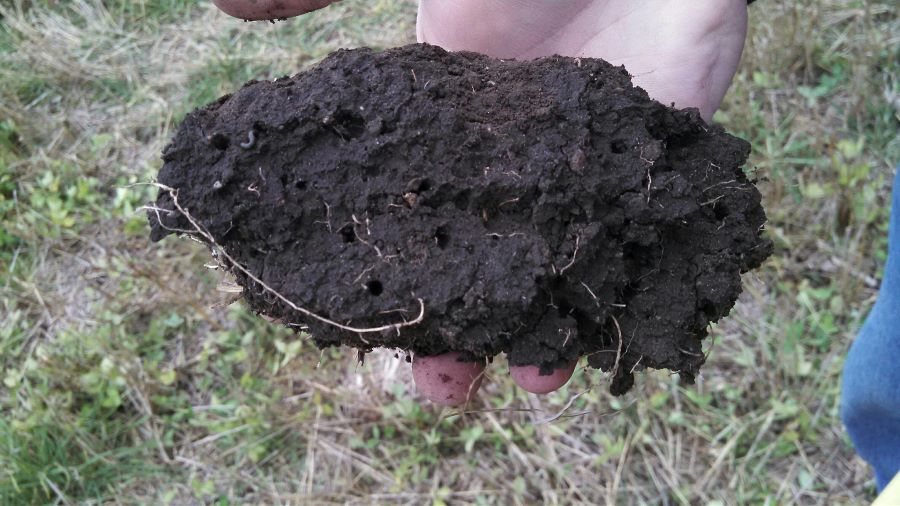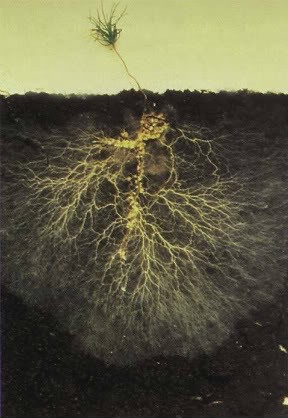Long ago when I started gardening, I learned that you want to feed the soil, not the plant. I took this to heart and it steered my approach to gardening. The idea was to foster good soil biology and let the soil organisms (microbes) do their work. Feeding the soil meant adding compost, manures, and the like.
But years later soil science has found so much more about plant roots. About their role in what’s called the soil food web. It’s fascinating and complex, and it will make you think differently about plants.
Plants have foliage for photosynthesis to make energy for the plant. Roots provide water and minerals, and anchor the plant.
But the roots do much more. Understand at least a little of this and you’ll be able to help your plants much more easily.
The roots are in charge; they’re farmers, they direct the biology of the soil to feed themselves. Let’s look at how it works.
Roots are farmers
Yes, they grow their own food! They farm in two ways to grow bacteria and fungi which in turn provide the right food, by way of all the other soil microbes, to the roots.
As roots grow, the root tips slough off cells ahead of where they go. This lubricates the soil for them, and it feeds bacteria and fungi.
Also, plants use some of their energy to secrete exudates from the roots—molecules that feed the bacteria and fungi. The exudates vary in composition and determine the type of organisms they feed. They may favor more bacteria or more fungi. They direct the microbes around them.
The rhizosphere is the area right around the roots which is about 2 mm thick (or a tenth of an inch). This area is full of a mix of tiny soil microbes: bacteria, fungi, and protozoa. Beyond the rhizosphere are larger organisms like nematodes, worms, sow bugs, centipedes, millipedes, and more.
The bacteria and fungi excrete wastes, and they die and decay. This is food for the next level of soil microbes, the protozoans and on up, and so on. Each soil microbe body is a sealed-up packet of fertilizer that stays in the soil, available to the roots. The roots vary their exudates to direct the microbes around them to produce the nutrients they need at the time. The roots are in charge.
Different plants need different forms of nutrients
Nitrogen, essential to plant life, comes in different forms: nitrates or ammonium. The fungi feeding on root exudates and shed root tip cells produce ammonium. Bacteria tend to produce nitrates.
Trees, shrubs, and most perennials need their nitrogen in ammonium form, while annuals, grasses, and most vegetables need nitrates.
Phosphorous is another essential plant nutrient. It tends to get locked up in the soil, unavailable to plants, even when we apply it as a fertilizer. But fungi go find and pick up phosphorous and carry it long distances to deliver it to roots, unlocked and ready to use. (Why do we ever interfere with this amazing beauty and efficiency?) The roots attract and feed the fungi with what it needs so the fungi will do what the root needs. The roots are in charge!
For our garden plants we can help them by supplying the organic matter that supports the soil food web to supply the microbes that support the plant roots. Organic matter in your garden soil can hold phosphorous so it’s available to the fungi to pick up when needed.
Most chemical fertilizers are made with nitrates, not ammonium. And most of the phosphorous gets locked up in the soil. When we use chemical fertilizers we give plants free food, so they don’t need to farm. And the soil food web players get killed off and the system breaks down. Then we need more fertilizer, costing us time, resources, and creating weak soils. Herbicides kill the soil organisms, too.
More benefits
All the players in the soil food web are growing, dying, consuming, excreting, and forming homes and colonies. This all adds biochemicals and aeration to the soil to create healthy soil structure. Structure that allows more water in and holds it, that holds nutrients in living and in decaying matter, and allows more oxygen in for the roots.
Another benefit is resistance to root problems. The bacteria and fungi that are in the sloughed off cells and exudate-rich rhizosphere coat and cover the roots. They protect their source of food against diseases and parasites. Fungi can trap and kill marauding nematodes. Bacteria produce slimes that trap pathogens. Destroy this system and you encourage soil problems.

Treat the soil nicely
If you’re preparing to plant, do not rototill the soil! This breaks up the soil structure and exposes that complex soil biology to the air and kills off the microbes. Instead, if you must open the soil, go gently with a digging fork to open but not turn the soil.
Use only organic fertilizers. They have the ingredients that supply food for the soil microbes, including phosphorus.
For annuals and vegetables add good organic compost to the soil each season. For trees, shrubs, and other perennials, use coarser organic amendments or composts as a mulch on the soil on the area extending outward from the stems to beyond the canopy of the plants. Earthworms and even fungi will bring the material down into the soil to start the feast for all the other soil organisms keeping them all fat, happy, and plentiful. This puts the raw materials nature normally provides on the soil surface, like fallen leaves, needles, sticks, and dead animals. At the base of this activity will be the director of each plant, the roots. The roots are in charge!
The book that opened my eyes to all this is Teaming With Microbes by Jeff Lowenfels and Wayne Lewis. Though that book was extremely thorough, author Jeff Lowenfels has come up with others; Teaming with Nutrients, good for new and experienced gardeners, and Teaming with Fungi, where you learn so much more about the mycorrhizal connections in the soil that benefit almost all plants, and how not to ruin them.
And the soil pioneer is Dr. Elaine Ingham. She’s the one who elucidated the science. You can learn more at soilfoodweb.com. They have courses that train people to become soil consultants, if you’re fascinated!
This page contains affiliate links
Related Reading:
Tree & Shrub Roots do Vital Work in Fall & Winter: Here’s How to Help Them
It’s Getting Hot! There’s a Surprising Solution to Global Warming
A Looming Drought? Catch Rainfall Now and Recharge Your Well & Soil

